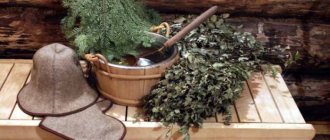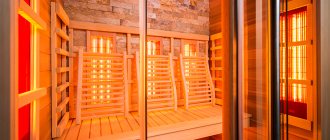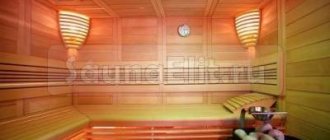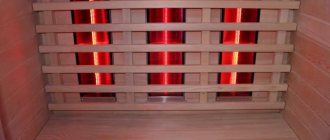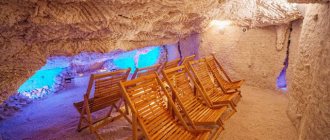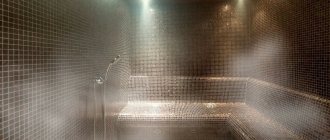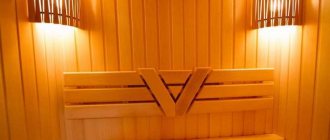Read an article on our website on the topic: “Massage in a bathhouse, bathhouse massage with a broom: technique for performing Russian massage with a broom, types of bathhouse brooms . You will learn a lot of useful information about aromatherapy and the best massage oils for bath massage with brooms, as well as how to use it correctly?
This article describes these types of baths. You will also learn which is better. The benefits, effects on the body and disadvantages of each bath will be described. Even if you just want to visit the steam room, but cannot choose from the steam rooms presented, then after reading the article, you will be able to decide. We will help you choose. Read on.
Finnish sauna: how does it work?
Finnish sauna
The heat source is a heater. How does this sauna work?
- The air is heated in the sauna to 90–100°C .
- It is very dry (hence why it is sometimes called a "dry sauna"), with a humidity of about 3% .
- By pouring water over the sauna stones, you can increase the humidity to 20% .
A special type of Finnish sauna is a biosauna. It uses a special BIO-cooker with an evaporator into which aromatic ingredients can be poured (aromatherapy). The biosauna is heated to a lower temperature, about 65°C , and thanks to the evaporator, it has a higher humidity, in particular about 30-60%.
The preparation time for the sauna is also important. It is necessary to understand that in the case of a Finnish sauna, the entire volume of air in the room must be heated. Therefore, it is important to select stoves of the appropriate power for each cabin size. Thus, the heating time is about 20-45 minutes from the moment the oven is turned on. After this time, the sauna is ready for use.
The recommended duration of stay in the sauna is about 10 minutes. It depends on each of us, here it is good to give sensations to our own body. A sauna should be followed by a cool down, ideally a quick cool down, followed by a cool down to relax the body. Therefore, inside there should be a pool with cold water, and benches or sofas on which you can sit and relax. The entire procedure can be repeated 2-3 times.
Effects of saunas on the body:
- It has been proven that regular use of the sauna improves immunity and is therefore a good preventive measure against flu or colds.
- Thanks to staying in the sauna and sweating, toxins are removed from the body, and the functioning of the heart, lungs and liver improves.
- The sauna is suitable for general strengthening of the body, cleanses the skin, helps with weight loss and as a prevention of cellulite.
- In addition, the sauna causes the release of endorphins into the body, which are hormones of happiness.
- In the sauna you can relax and forget about problems and worries.
Flaws:
- This steam room is not suitable if you are being treated for high blood pressure, epilepsy or if you are in the 1st trimester of pregnancy.
- In general, the Finnish sauna is not suitable for people who do not like elevated temperatures, if you have non-healing open wounds or inflammatory diseases.
Let's face it - this Finnish steam room is classic, beautiful, but more expensive than infrared - both its acquisition and operation. Disadvantages may also include more complex maintenance and the need for a ventilated area.
The benefits of hamam
- Cleanses any skin, moisturizes dry skin, normalizes oily skin.
- Cleanses from toxins and impurities.
- Helps relieve colds, fever and bronchitis.
- Normalizes blood circulation, digestion and lung function.
- Relieves asthma.
- Relieves fatigue.
- Normalizes sleep.
- Helps overcome stress and depression.
- Aromatherapy.
Infrared sauna: how does it work?
Infrared sauna
Special infrared emitters emit rays that barely heat the air in the sauna, but penetrate deep into your body and thus directly heat it. Air temperature is around 30-60°C . How it works?
- Due to the heating of body tissues, strong sweating occurs, and since the temperature in the cabin is low, this sauna method is more gentle on the body.
- If the infrared sauna uses high-quality heaters, then it is ready for use a second after it is turned on, that is, immediately.
- Conventional radiators heat up in a few minutes.
- This fact significantly affects energy intensity.
- Buying a cheap infrared sauna can become more expensive over time due to electricity bills.
The operating cycle in an infrared sauna can be extended to 20-45 minutes due to a more favorable temperature. After this, the body should recover and rest. The procedure should not be repeated, but you can use the sauna several times a week (but always once a day).
How does it affect the body? Explanation:
- An infrared sauna is suitable for those who do not like high temperatures in a Finnish steam room.
- The infra-steam room can be used by asthmatics, allergy sufferers or people with blood pressure above 140/100.
- If you play sports, this type of steam room is ideal before a sports performance. It warms up the muscles and improves their elasticity.
The infrasauna will perfectly help with joint pain, minor skin diseases, treats scars, eczema, acne. The special heat in this steam room relaxes the airways, improves skin elasticity and removes impurities. This works well if you also want to lose weight and as a cellulite preventative. Heat relaxes the airways and relieves fatigue, improving sleep.
Flaws:
- An infrared sauna is not suitable if you are being treated for a joint or infectious disease.
- Like the Finnish sauna, its use is not recommended for expectant mothers in the first trimester.
Visiting an infrared sauna is also not suitable for patients with hemophilia. Now let's compare several types of baths. Read on.
Roman bath
One of the most ancient types of baths. In fact, the baths are prototypes of Turkish hammams. These are also stone buildings with central heating and heated floors and walls. The modern Roman bath is distinguished by marble-clad rooms with heated marble loungers. The thermal bath was divided into separate rooms that had to be visited sequentially. They were called: caldarium, tepidarium, frigidarium.
The modern caldarium is a room decorated with ceramic tiles, heated floors and a large bathtub with water. Humidity in the caldarium is kept at 80-100%, temperature 37-45 ⁰C. The room is usually filled with the aromas of essential oils of healthy herbs and plants. Great importance is attached to design; caldariums are usually decorated in warm colors, with picturesque paintings from the life of Ancient Rome placed on the walls.
Tepidarium is a room with dry warm air. The temperature here, just like in the caldarium, is maintained at 37-45 ⁰C, but the humidity is much lower, only 30%. The tepidarium is equipped with marble beds and armchairs. Heating, as in all rooms of the Roman baths, is carried out from below. The tepidarium is comfortable for a fairly long stay. After visiting it, the body will require replenishment of moisture.
Frigidarium is a cool room with a swimming pool, where you go after visiting the tepidarium and caldarium to refresh and relax.
What is good about a Finnish, infrared sauna - which is better: the main difference is in warming up
Everything for a bath or sauna
In a typical Finnish steam room, a sauna stove is used as a heat source. What's good about her?
- Currently, these rooms are made mainly electrical and they have convenient touch controls.
- But true sauna connoisseurs like to heat the stove only with wood.
- The electric heater heats the air and skin. Humidity can be adjusted by pouring water onto the stones. Steam is produced, increasing humidity.
Read an article on our website on the topic: “Essential oils for baths and saunas - disinfecting, soothing, healing, tonic, stimulating . You will learn about methods of use, recipes for aromatic mixtures, important rules of use.
The main difference between a Finnish sauna is the warm-up:
- An infrared sauna uses the same radiation, which is created by special emitters.
- The air hardly heats up, but infrared radiation penetrates your body and heats deeper, not just the surface of the skin, as in a Finnish sauna.
- The infrared cabin has modern high-quality spotlights that can produce almost the entire spectrum of such radiation. Your body warms up to a depth of several centimeters.
This is a very interesting feeling, incomparable to anything. Therefore, connoisseurs of the Finnish steam room will not understand lovers of infrared, and vice versa.
Finnish sauna or Russian bath: which is better?
Finnish sauna or Russian bath
Our people are accustomed to visiting an ordinary national bath. It feels good for both soul and body. But now the Finnish dry steam room is also popular in our country. There are distinctive features, although many do not notice them. So, which is better - a Finnish sauna or a Russian bath? Here are the main differences:
Dry steam:
- In a Finnish steam room it reaches only 20%, in a Russian bath it is much higher, 70%.
- Therefore, in our traditional steam room, the whole body warms up well, and all harmful substances are better removed along with sweat.
- It will be difficult for people with respiratory pathologies to stay in a Finnish sauna.
- Dry air leads to swelling of the mucous membranes, coughing and even spasms.
Ventilation:
- It's better in the Finnish steam room. The ventilated system is the main part of the entire structure.
- Air pressure is supplied both indoors with steam and outside. Therefore, the air is well heated and at the same time dry.
- Hot steam rises to the ceiling, and the floor remains cool.
Architectural features:
- The Russian bathhouse is built from logs and timber.
- Wood has a good effect on all organs and systems, the body as a whole. Visually, such a building also looks more attractive.
- An integral part of the Russian steam room is the dressing room and steam room.
- The steam room has a low ceiling and a minimum size in area. This is how the room needs to be heated well.
- The stove is installed between the steam room and the dressing room. It is made of stones that are heated to high temperatures. Due to the fact that you need to pour water on them, you can regulate steam production and temperatures throughout the room.
- The Finnish steam room is also small and is built from logs.
- The stove in such a sauna is similar to the stove in a Russian bath.
- The steam room is smaller in size when compared to a Russian bathhouse. Special ventilation - air is supplied forcibly.
- In the bathhouse, a barrel is used for cooling, as well as a river, lake or other body of water that is located next to the building. The sauna has a regular small pool.
Why it’s useful:
- The bathhouse contains hot steam, which has a good effect on all systems and organs of the body: cleanses pores, rejuvenates, accelerates metabolism, improves blood circulation and relaxes.
- In a sauna, dry steam has a good effect and heals the genitourinary system. Also, such an atmosphere is beneficial for the nervous and respiratory systems: it dilates blood vessels, helps speed up the movement of blood, helps relieve symptoms of psoriasis, urticaria and other skin rashes, improves the condition of the mucous membranes, and strengthens the immune system.
If we talk about harm, then it exists for the Finnish sauna and Russian bath. It is better not to enter such premises:
- Women who are expecting a child
- People with cardiovascular diseases
- Suffering from high blood pressure
- With oncopathologies
- After the operations performed
You should not go to a sauna or steam bath after any physical activity - fitness, exercise equipment, running, etc., and you should also not eat a lot before the procedures. Eat within 2 hours. Before going to the bathhouse or sauna, use a special felt cap to protect your head, and do not sit on the shelves, but rather lie down and relax.
Features of using the hammam
- After completing all the work, you need to let your hammam stand for a couple of weeks, slightly maintaining the heating of the surfaces. This is done to ensure that all solutions and adhesives dry completely.
- The first start-up should be long and gradual, with a slow increase in heating temperature. This is done to prevent thermal expansion from causing the surfaces to crack. This is especially dangerous for all-stone and all-marble surfaces.
- During short breaks in the hammam operation, all heating should not be turned off. If the break is expected to be long, you need to leave the heating on the benches and massage table.
- It is necessary to keep the hammam clean and frequently clean it with special detergents for marble, tiles, and glass.
- If the water is hard, you need to remove scale from the steam generator tank on heating elements using a solvent according to the instructions, depending on the hardness at certain intervals: the harder the water, the more often. In addition, the steam generator must self-clean every few hours: drain water from the tank and add new water.
- During steaming, the ventilation hole should be kept slightly open, since the air exchange you need is equal to 4-6 volumes of your hammam per hour.
If you follow these simple rules, your hammam will serve you for a long time and will not cause any problems.
Hammam or Finnish sauna: which is better?
Hammam
Steam room is the best place to relax the nervous, cardiac and vascular systems of the body. Pores are cleansed, dead cells are removed, and toxins are removed. In addition to the Russian bath, the most popular steam rooms are the Turkish hammam and the Finnish sauna. What is better, how to make a choice?
The fact that the Finnish steam room is useful was described above. It helps to relax, fight stress, relieve fatigue, train blood vessels and improve the functioning of the immune system. A Turkish hammam is a steam room with “soft” and wet steam. The temperature in such a steam room reaches only 45-50°C. The air here is very delicate at temperature, so the Turkish steam room can be visited by pregnant women, people with heart disease, skin problems and various inflammatory processes.
The benefits of hamam are as follows:
- The muscles warm up, the metabolic process accelerates
- There is a fight against stress, complete relaxation
- Body systems are cleansed of toxins, blood circulation improves
Hammam has a good effect on the skin, removing inflammation. If there are symptoms of diseases of the respiratory system, then it is recommended to give preference to a Turkish bath, since its steam not only heals, but also rejuvenates. After training in the gym, it is also good to go to the hammam to relax and unwind.
Tips for choosing material
Construction supermarkets offer a large selection of materials for finishing such a structure. Requirements for facing materials:
- moisture resistance;
- high strength;
- heat resistance.
Marble is best suited for interior decoration of a hammam.
Marble is expensive, but it also has a long service life
Marble is smooth to the touch, retains heat for a long time, is durable and can emphasize the status of the owner of a private home. A significant disadvantage of this material is its high cost. Soapstone is comparable to marble in price, but surpasses it in heat capacity. It can help reduce sudden temperature changes.
An affordable replacement for marble is tiles and small mosaics. Smalt is a fine-grained mosaic made of glass of different colors: it can be used to create beautiful exclusive canvases with oriental ornaments. The color of the material shimmers under different lighting angles.
Smalt finishing decorates the room: it can be used to lay out multi-colored panels on the walls
Smalt is produced in the form of plates or tiles ranging in size from 2 cm² to 4 cm², it can be rough and smooth, colored and colorless. Places on flat or curved surface. The main advantages of this finish:
- zero water absorption;
- frost resistance;
- heat resistance;
- unique color design of patterns.
There is only one drawback: laying out the mosaic is time-consuming. But on sale you can find ready-made mosaic panels that make the work easier.
The most affordable of all materials is ceramic tile. In addition, it is easy to install.
Ceramic tiles are easier and faster to lay than small mosaics
If you have no experience in decorating hammams, then it is recommended to choose a simple finishing method. It is not necessary to lay out a mosaic; you can buy tiles of a similar type and lay out the desired patterns. Some manufacturers have developed and launched Eastern series ceramics.
Finnish sauna with a swimming pool, Russian sauna made of timber, hammam or infrared sauna: what to choose?
So what should you choose? Finnish with a pool or infrared sauna? Russian bath or hammam? It's up to each of you to decide. Some people like the whole sauna ritual, the smell and sound of crackling wood in the stove, the whistling of birch brooms, and jumping into a pool of ice-cold water. If you are like that, then choose a Finnish sauna or a Russian bath.
If you don’t have enough space in the steam room, you don’t like high temperatures and dry air, if you treat the sauna as normal care for your body and mind, if you play sports, then go to the infrared sauna. You can also give preference to the Turkish hammam.
And it will help you most in your choice if you can see a Finnish and infrared sauna in one place. Visit a Russian bathhouse and go to the hammam. This is the only way it will be easier to make a choice and determine what you like more and what is better.
Calculation of materials and list of tools for construction
To build a Turkish bath with your own hands, you will need the following materials:
- Styrofoam;
- mortar of cement and sand;
- polyurethane adhesive mixture;
- tile adhesive;
- concrete;
- elements for fastening;
- bars of great thickness;
- waterproofing material;
- plaster;
- insulation material;
- putty;
- Entrance door;
- foam blocks or bricks;
- finishing material.
Prepare your tools:
- rubber coated hammer;
- building level;
- putty knife;
- plumb line;
- hammer drill
You can calculate the required amount of material for finishing using the following formula: N = Sp / Smat, where N is the amount of material, Sp is the area of the base, Smat is the area of one part of the material. It is recommended to take tiles with a margin of 5–10%. If the room area is 8 m² and the tile size is 35x35 cm², then the calculation will be as follows: N = 8 / (0.35 x 0.35). Accordingly, you will need approximately 70 tiles.
